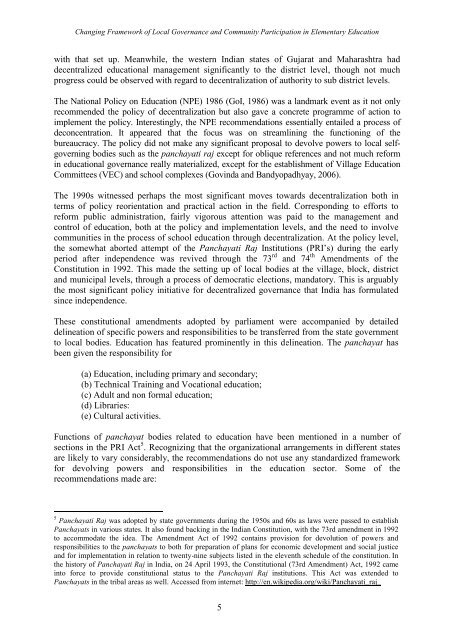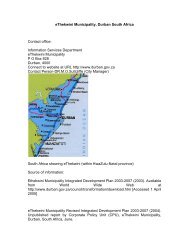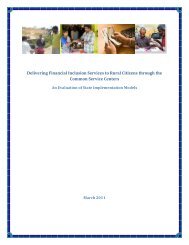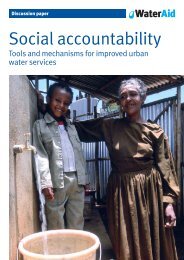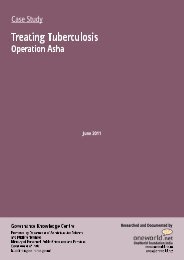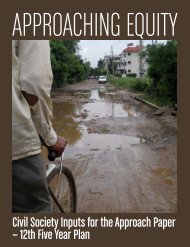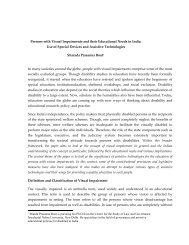Changing Framework of Local Governance and - Create
Changing Framework of Local Governance and - Create
Changing Framework of Local Governance and - Create
You also want an ePaper? Increase the reach of your titles
YUMPU automatically turns print PDFs into web optimized ePapers that Google loves.
<strong>Changing</strong> <strong>Framework</strong> <strong>of</strong> <strong>Local</strong> <strong>Governance</strong> <strong>and</strong> Community Participation in Elementary Educationwith that set up. Meanwhile, the western Indian states <strong>of</strong> Gujarat <strong>and</strong> Maharashtra haddecentralized educational management significantly to the district level, though not muchprogress could be observed with regard to decentralization <strong>of</strong> authority to sub district levels.The National Policy on Education (NPE) 1986 (GoI, 1986) was a l<strong>and</strong>mark event as it not onlyrecommended the policy <strong>of</strong> decentralization but also gave a concrete programme <strong>of</strong> action toimplement the policy. Interestingly, the NPE recommendations essentially entailed a process <strong>of</strong>deconcentration. It appeared that the focus was on streamlining the functioning <strong>of</strong> thebureaucracy. The policy did not make any significant proposal to devolve powers to local selfgoverningbodies such as the panchayati raj except for oblique references <strong>and</strong> not much reformin educational governance really materialized, except for the establishment <strong>of</strong> Village EducationCommittees (VEC) <strong>and</strong> school complexes (Govinda <strong>and</strong> B<strong>and</strong>yopadhyay, 2006).The 1990s witnessed perhaps the most significant moves towards decentralization both interms <strong>of</strong> policy reorientation <strong>and</strong> practical action in the field. Corresponding to efforts toreform public administration, fairly vigorous attention was paid to the management <strong>and</strong>control <strong>of</strong> education, both at the policy <strong>and</strong> implementation levels, <strong>and</strong> the need to involvecommunities in the process <strong>of</strong> school education through decentralization. At the policy level,the somewhat aborted attempt <strong>of</strong> the Panchayati Raj Institutions (PRI’s) during the earlyperiod after independence was revived through the 73 rd <strong>and</strong> 74 th Amendments <strong>of</strong> theConstitution in 1992. This made the setting up <strong>of</strong> local bodies at the village, block, district<strong>and</strong> municipal levels, through a process <strong>of</strong> democratic elections, m<strong>and</strong>atory. This is arguablythe most significant policy initiative for decentralized governance that India has formulatedsince independence.These constitutional amendments adopted by parliament were accompanied by detaileddelineation <strong>of</strong> specific powers <strong>and</strong> responsibilities to be transferred from the state governmentto local bodies. Education has featured prominently in this delineation. The panchayat hasbeen given the responsibility for(a) Education, including primary <strong>and</strong> secondary;(b) Technical Training <strong>and</strong> Vocational education;(c) Adult <strong>and</strong> non formal education;(d) Libraries:(e) Cultural activities.Functions <strong>of</strong> panchayat bodies related to education have been mentioned in a number <strong>of</strong>sections in the PRI Act 5 . Recognizing that the organizational arrangements in different statesare likely to vary considerably, the recommendations do not use any st<strong>and</strong>ardized frameworkfor devolving powers <strong>and</strong> responsibilities in the education sector. Some <strong>of</strong> therecommendations made are:5 Panchayati Raj was adopted by state governments during the 1950s <strong>and</strong> 60s as laws were passed to establishPanchayats in various states. It also found backing in the Indian Constitution, with the 73rd amendment in 1992to accommodate the idea. The Amendment Act <strong>of</strong> 1992 contains provision for devolution <strong>of</strong> powers <strong>and</strong>responsibilities to the panchayats to both for preparation <strong>of</strong> plans for economic development <strong>and</strong> social justice<strong>and</strong> for implementation in relation to twenty-nine subjects listed in the eleventh schedule <strong>of</strong> the constitution. Inthe history <strong>of</strong> Panchayati Raj in India, on 24 April 1993, the Constitutional (73rd Amendment) Act, 1992 cameinto force to provide constitutional status to the Panchayati Raj institutions. This Act was extended toPanchayats in the tribal areas as well. Accessed from internet: http://en.wikipedia.org/wiki/Panchayati_raj_5


